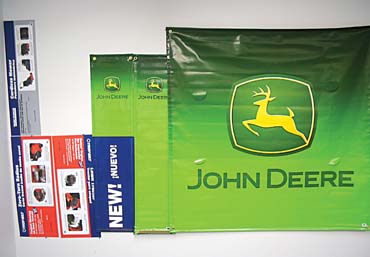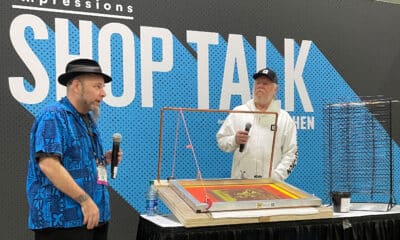Articles
The Future of Wearable Technology
Published
8 years agoon

The Internet of Things (IoT) is taking shape, and the specialty printing industry is very much a part of the evolution. The IoT’s ambitious goal is to connect systems, people, and entities to enable us to capture, analyze, and act on information to improve the quality of our lives and make businesses more efficient. It’s transforming all sorts of things – factory equipment, home appliances, thermostats, retail stores, and security systems – and in our industry, it’s already at work in automating our workflows.
The Internet of Things (IoT) is taking shape, and the specialty printing industry is very much a part of the evolution. The IoT’s ambitious goal is to connect systems, people, and entities to enable us to capture, analyze, and act on information to improve the quality of our lives and make businesses more efficient. It’s transforming all sorts of things – factory equipment, home appliances, thermostats, retail stores, and security systems – and in our industry, it’s already at work in automating our workflows. Sensors track how much ink, time, and media is used on each print job and send the data to a print MIS for accurate estimating and real-time dynamic scheduling on digital displays.

But the IoT is also changing the way fashion designers and apparel manufacturers think about textiles and manufactured garments. Electronically interactive “smart clothing” is expected to be part of the IoT and it could help everyone from infants to the elderly live more safe and healthy lives in the comfort of their own homes.
For example: What if technology-infused garments could help doctors reduce hospital stays and improve patient care remotely? What if sensors in apparel could help prevent Sudden Infant Death Syndrome in nurseries, concussions on the football field, or casualties in combat?
What if your T-shirt could tell the fitness app on your smartphone that you were physically ready to handle more intense workouts? What if a garment punished you with a mild electric shock each time you lied? What if golf gloves could help you monitor and correct your golf swing? What if bicycling gloves could light up to display a “turn signal” just like on a car? All of these ideas (and many more) have already been floated either as concepts or prototypes.
punished you with a mild electric shock each time you lied? What if golf gloves could help you monitor and correct your golf swing? What if bicycling gloves could light up to display a “turn signal” just like on a car? All of these ideas (and many more) have already been floated either as concepts or prototypes.
Within the next few years, everyone who carries a smartphone or other Bluetooth device might be able to use an app to control how a specific garment looks, communicates, or functions. Eventually, we might not need to carry a smartphone at all. Your clothing could transmit data directly to electronics and displays printed on wallcoverings and window films or built into household devices.
In theory, the possibilities for wearable technologies seem limited only by designers’ imaginations. But in the real world, the commercialization potential of some of these ideas will depend on two things: The ability to create durable, washable, and reliable low-power electrical components that can be safely and comfortably worn close to the skin; and the ability to produce smart textiles and clothing at prices that everyone can afford.
Why Screen Printers Should Pay Attention
According to the emerging technologies research firm IDTechEx, the market for wearable technology will grow from $24 billion today to more than $70 billion in 2025. But the term “wearable technology” means different things to different people. The market today consists primarily of non-washable objects such as wristwatches, fitness trackers, earphones, and medical devices like EKG, EEG, and blood glucose sensors. Newer wearables include virtual reality headsets and “Magic Band” wristbands that customize the experience of each visitor in a Disney theme park.
Whole new waves of opportunities will arise as researchers continue to develop thin, conformable, flexible electronic components that can be integrated with smart textiles. Silicon Valley tech firms regard such printed electronics as an enabling technology for the low-cost fabrication of low-power electronic components that could be worn close to the skin and move easily with the wearer’s body. (The term “printed electronics” refers to the deposition of electrically functional or optical inks in patterns and thicknesses that will create active or passive devices such as thin-film transistors, capacitors,
coils, and resistors.)
One screen-printing expert who has seen the rapid advancement of flexible electronics for wearables firsthand is Ray Greenwood. As an independent industrial, medical, and electronic printing consultant and contractor, he has worked in the sensor end of the medical electronics industry since 2011, starting out with products such as defibrillator pads and EEG and EKG electrodes. His work has quickly expanded into developing flexible devices for sports medicine, blood-flow monitoring, and electrochemical electrodes for very specific functions.
With his extensive background in screen printing, offset lithography, plastics, product design, and manufacturing, Greenwood says screen printing is already playing an important role during this R&D phase. While industrial inkjet and 3D deposition printers are quickly being developed to make printed electronics, rotary screen-printing equipment is already being used to print RFID antennas and blood glucose sensors, and traditional cylinder and flatbed lines are being used for a host of other applications.
AdvertisementTwo advantages that screen printing offers are its availability and versatility. “Any non-solid substrate can become an ‘ink,’” says Greenwood. “And any material can become a printable substrate.”
As ideas for different types of smart clothing multiply, a screen printer’s first contract for printed electronics is more likely to come from a circuit designer than an apparel manufacturer. Startup companies are already designing the types of sensors and circuitry that apparel brands might want to incorporate into clothing.
Other entrepreneurial circuit designers are seeking screen printers who can help print proof-of-concept designs, create and test prototypes, and make short runs of garments for test marketing. Right now, only a small number of smart garments are being produced and sold to the public.
“These are cutting edge products,” Greenwood emphasizes. Wearable technologies not only have to be accurate and reliable, but must also be comfortable and stylish. “Plus, they may have to pass regulatory and process hurdles that haven’t yet been defined.” (.)
Application Ideas Simulate Research
Companies that make conductive inks, substrates, and specialized printing devices for manufacturing printed electronics are currently taking a wait-and-see approach. They want a clearer picture of which smart textile applications are most likely to scale up first.
“Printed electronics are already the next big thing in the medical device industry,” says Greenwood. “And it has the potential to get even larger in the medical field.”
AdvertisementAs sensors become more flexible and cheaper and easier to produce, the market for wearable printed electronics is expected to grow well beyond healthcare, the military, and haute couture into affordable, ready-to-wear garments for athletes, gamers, babies, and fashionistas. Here are just a few of the many ideas being explored in various markets that can benefit from flexible electronics:
Healthcare: In the medical field, it’s easy to justify the production of a $400 garment that can significantly reduce the length of a hospital or nursing-home stay. Data can be continuously delivered from a patient’s garment directly into their electronic health records. Advances in sensor technology and microelectronics can also improve clinical trials of new treatments by reducing interactions between providers and patients while improving the quality of the data received from the patients. Electronics on adhesive patches placed on the skin could control and monitor the dosage of prescribed medicines.
Fitness: Sensors built into socks, gloves, T-shirts, and helmet padding can help all types of athletes monitor and improve their performance. For example, Ralph Lauren’s PoloTech smart shirt ($295) connects with an adaptive workout app that can customize a training regimen to match biometric data sent from the shirt. Silver fibers woven directly into the fabric track stats such as heart rate and variability, breathing depth and recovery, intensity of movement, energy output and stress levels, steps taken, and calories burned. A “black box” mounted on the shirt collects and processes the data and contains a 3D accelerometer that captures the intensity of movement based on three g-force measurements. Using the unique bio- and psychometric data from the shirt, the smartphone will display different videos for core, strength, and agility exercises. The shirt and app were developed in collaboration with OMsignal, a biometric technology company that is helping apparel brands develop seamless connections between bodies, textiles, and technologies.
At the 2016 Consumer Electronics Show in Las Vegas, a Singapore-based fashion and technology startup called AiraWear showcased a “smart hoodie” that can give stressed-out wearers a massage. At the touch of a smartphone, the jacket uses air pressure to deliver a tension-relieving backrub.
 At the 2015 IDTechEx Printed Electronics USA show last November, Sensoria won the “Best New Wearable Technology Device” award for its “Smart Socks.” Each sock includes three thin, soft textile pressure sensors. A magnetic Bluetooth smart electronic anklet snaps onto each sock, collecting and transmitting the data from the sensors wirelessly to Sensoria’s mobile app and web dashboards. Runners can use data about foot landing, cadence, and time on the ground to improve their form and performance. Sensoria’s Smart Socks can be used with the company’s smart sports bras or T-shirts. These upper-body garments feature integrated heartrate monitoring without the hassle of wearing a chest strap.
At the 2015 IDTechEx Printed Electronics USA show last November, Sensoria won the “Best New Wearable Technology Device” award for its “Smart Socks.” Each sock includes three thin, soft textile pressure sensors. A magnetic Bluetooth smart electronic anklet snaps onto each sock, collecting and transmitting the data from the sensors wirelessly to Sensoria’s mobile app and web dashboards. Runners can use data about foot landing, cadence, and time on the ground to improve their form and performance. Sensoria’s Smart Socks can be used with the company’s smart sports bras or T-shirts. These upper-body garments feature integrated heartrate monitoring without the hassle of wearing a chest strap.
Military: The integration of electronics with fabrics will enable soldiers to carry lighter-weight batteries and equipment with heads-up displays, chemical and biological threat detectors, and combat ID sensors. Personal physiological status sensors can measure fatigue or send alerts to rescue personnel when soldiers are exposed to explosive forces.
Infotainment: As virtual reality systems become popular forms of entertainment, education, and training, sensors mounted on gloves or garment sleeves can precisely track how a person wearing a virtual reality headset actually moves. By using the body as an input device, the immersive games or training programs become more realistic
and effective.
Fashion: Designers and artists have been imagining what might be possible with interactive clothing for at least five years. Visitors to the “Coded_Couture” exhibit at the Pratt Institute in New York, which runs until April 30, will see groundbreaking concepts from a variety of artists and designers. For example, designer Ying Gao has made interactive dresses that combine super organza (a lightweight fabric that blocks air-conditioning drafts in the summer and provides thermal insulation in the winter), photoluminescent threads, PVDF (a thermoplastic), and embedded eye-tracking technology. When the eye-tracking technology is activated by a viewer’s gaze, the wearer knows she’s being noticed.
“Coded_Couture” exhibit at the Pratt Institute in New York, which runs until April 30, will see groundbreaking concepts from a variety of artists and designers. For example, designer Ying Gao has made interactive dresses that combine super organza (a lightweight fabric that blocks air-conditioning drafts in the summer and provides thermal insulation in the winter), photoluminescent threads, PVDF (a thermoplastic), and embedded eye-tracking technology. When the eye-tracking technology is activated by a viewer’s gaze, the wearer knows she’s being noticed.
Francesca Rosella and Ryan Genz of CuteCircuit, founded in London in 2004, believe that wearable technology is not a gadget strapped to your wrist. “A piece of wearable technology should be a beautiful garment that allows the human body to become an interface, a sort of second skin, that can connect us to people and places, even far away and remote ones,” the duo says in a statement on their website. CuteCircuit creations include a mini-dress that changes color as the wearer moves. The dress is machine washable and USB rechargeable. A Twitter-controlled black evening dress changes color when the wearer receives a tweet. Katy Perry lit up the Met Gala red carpet wearing a twinkling CuteCircuit gown.
Artist Melissa Coleman, who co-curated the Dutch traveling exhibition Pretty Smart Textiles that toured Europe from 2010-2012, designed a dress that lights up when biosensors detect that the wearer may be telling a lie. The intensity of the light grows as the likelihood of a lie increases. Once the dress determines the wearer is lying, it can punish her with an electric shock. Coleman currently teaches with Codasign in London.
Automotive: Soft sensors in automotive upholstery or seatbelts could automatically adjust safety features such as airbags or detect medical emergencies such as heart attacks or seizures. Seatbelt harnesses could detect body temperature and then adjust cabin temperature or window-tint levels.
Strategic Alliances Are Now Forming
Research on smart textiles, thin-film components, and soft sensors has been progressing for well over a decade. But it is shifting into high gear with the ubiquity of smartphone apps, the adoption of electronic medical records, and advances in nanotechnology and the IoT.
The increased pace of R&D has spawned dozens of new startups and research labs. To help advance flexible, printed electronics from R&D to commercialization, FlexTech Alliance was formed to support expanded collaboration among industry, academia, and research organizations.
In August, the Obama administration announced a new flexible hybrid electronics manufacturing innovation hub in Silicon Valley. More than $171 million will be invested in efforts to improve the US’ standing in pioneering next-generation bendable and wearable electronic devices.
As part of this effort, the US Department of Defense awarded FlexTech Alliance $75 million in federal funding over a five-year period to establish and manage a Manufacturing Innovation Institute for Flexible Hybrid Electronics (nextflex.us). The Institute’s activities will benefit a wide array of markets beyond defense, such as automotive, communications, consumer electronics, medical devices, healthcare, transportation, and agriculture. The Institute will distribute R&D funds via competitive project calls driven by industry-generated technology roadmaps. Supporters include more than 162 companies, non-profits, labs, and universities, including Apple, HP, Boeing, General Motors, and Stanford.
Printing Technologies
In an article on Forbes.com, Pratt Institute instructor Rebeccah Pailes-Friedman notes that “successful wearable technology companies will start with the design first, then build the technology around it.” But which printing technologies will they employ?
Because screen printing is already a proven and versatile technology, with a clear track record in printing all types of textiles, it is already being employed in these cutting edge wearable technologies. Manufacturers of screen-printing inks and equipment are actively researching how their existing materials and printing processes might be used in some of the new applications that the designers are dreaming up.
Greenwood, who has visited more than 3200 plants in dozens of industries, says inkjet can’t yet compete with screen printing, especially for designs that require the application of thick coatings such as the deposition of conductive inks for printed circuits. Screen printing can produce everything from moderately thin films (down to a few microns) to enormously thick films with fairly fine detail, giving it tremendous adaptability in many emerging industrial markets.
Inkjet, though it is the focus of intense R&D for all types of textile applications, is not used in the bulk of the printed electronics work being done on an industrial scale today. Among other limitations, if an inkjet process requires numerous passes to create deeper depositions of conductive materials, microvoids between the layers can affect the transmission of data or currents. Flexography, gravure, and offset can produce very fine detail with 1- to 6-micron accuracy at very high speeds, but cannot handle thicker depositions and have substrate limitations as well.
In May 2014, FlexTech Alliance and Drs. Xiaoying Rong and Malcolm Keif of the Graphic Communication Department at Cal Poly State University completed a screen-printing study for printed electronics applications. Their report, “Characterizations of Screen Printing Low Viscosity Ink, Thin Film and Small Features for Printed Electronics Applications,” explored whether screen-printing processes could produce fine features (30 microns or less) and thin ink films (a few microns to submicron) while using inks with much lower viscosity than typical screen-printing inks. The study also investigated the impact of mesh technologies, ink rheology, and printing conditions on feature quality measured in width, thickness, and electrical resistance.
“Screen printing is a widely used process for the electronics industry,” noted Michael Ciesinski, president and CEO of FlexTech Alliance. “If screen printing can produce finer features and utilize thinner ink films, it will help the industry replace more expensive processes and expand existing screen-printing lines for new printed electronic products.”
The study concluded that ink rheological properties play a significant role in printing fine features. “With optimized printing parameters, fine features can be screen printed with commercially available inks, mesh, and emulsion,” Dr. Rong explained. “The conclusion of this study supports screen printing as a cost-effective production method that can simplify the fabrication processes while utilizing existing technology and equipment to service the printed electronics industry.”
Greenwood agrees that ink rheology really matters and urges his clients to understand the rheology of every component involved in printed electronics. For example, the shape and texture of particles can be just as critical to ink rheology as particle size. He notes that screen printing can handle inks with very difficult ink rheologies as well as acids, caustics, and electrolytic materials.
As the demand for thin-film flexible electronics grows, some types of applications might be better suited for production with industrial inkjet printers, gravure, flexo, or offset printing equipment. Each printing process has certain strengths and limitations that can be adapted for specific types of applications. For example, industrial inkjet printers might be used to customizing the final wearable products or applying adhesives to irregular surfaces and complex geometries such as athletic shoes.
New purpose-built equipment for electronics prototyping and production is also being developed. According to a study by BCC Research, the global market for thin-film printing equipment should quadruple from $237.8 million in 2015 to $973.7 million in 2020. Factors driving the demand for thin-film printing equipment include the need for low-cost deposition processes and a growing availability of nanomaterials with improved properties at reduced unit prices.
Soft Sensors
One key component of wearable technology will be “soft” sensors that can be placed directly on the body or glued, sewn, molded, or mounted onto flexible materials. These sensors will be designed to record accurate data about any change in the shape or structure to which the sensors are applied.
 Soft and stretchy sensors can directly measure human movement without interfering with it. In athletic gear, these sensors can give coaches a better understanding of body motion, muscle contraction, breathing rates, movement techniques, posture, and risk of injury. Soft sensors in the padding of a football helmet could help monitor and reduce concussions.
Soft and stretchy sensors can directly measure human movement without interfering with it. In athletic gear, these sensors can give coaches a better understanding of body motion, muscle contraction, breathing rates, movement techniques, posture, and risk of injury. Soft sensors in the padding of a football helmet could help monitor and reduce concussions.
One company pioneering soft sensors is BeBop Sensors, a startup that designs custom turnkey sensor solutions for apparel OEMs. Their ultra-thin, wearable smart fabric sensor measures all aspects of physicality, including bend, location, motion, rotation, angle, and torque, and continuously provides real-time reporting. Markets include clothing and protective wear, shoes, healthcare devices, athletic equipment, automotive, robotics, aerospace, gaming, biometrics, and prosthetics. Sensors in the sleeves of jackets and shirts can connect to smartphones to answer calls or adjust volume to select songs while the phone remains tucked in the user’s pocket. Applied to the insoles of shoes, BeBop sensors can measure gait, pressure, contact style, fit, and flexure of toes and feet.
Technology Companies to Watch
Any company that seeks to profit in wearable technologies should stay up to date on all types of emerging technologies, research, and patents. IDTechEx and other information sources can help you keep abreast of these emerging opportunities and identify when products are being overhyped. Here are just a few of the companies you should get to know:
DuPont Microcircuit Materials: At the Printed Electronics USA conference in November, Dr. Michael Burrows of DuPont Microcircuit Materials discussed “The Missing Link for Smart Clothing – Manufacturable Stretchable Electronics.” He says that making functional electric devices with the look and feel of fabric is incredibly challenging. DuPont Microcircuit Materials has developed stretchable electronic inks. These screen-printable inks can produce the signal-carrying capacity of traditional electronics in a thin form that doesn’t compromise the comfort of the garment. With the proper manufacturing techniques, DuPont says the printed electronics will be rugged and washable.
According to Burrows, smart clothing can be made by screen printing a stretchable sensor and stretchable conductor in layers onto an elastomer film (the company’s thermoplastic polyurethane, Hytrel), then overprinting an encapsulant to protect the  electronics from oxygen and water exposure. The screen-printed thin film/conductor/sensor/overprint construction would then be laminated to the fabric used to construct the garment. At the 2015 Printed Electronics USA show, DuPont introduced the second generation of its stretchable electronic inks, including a silver chloride sensor for use in medical applications.
electronics from oxygen and water exposure. The screen-printed thin film/conductor/sensor/overprint construction would then be laminated to the fabric used to construct the garment. At the 2015 Printed Electronics USA show, DuPont introduced the second generation of its stretchable electronic inks, including a silver chloride sensor for use in medical applications.
Eventually, Burrows said, the stretchable inks could be printed directly on fabric. To date, the best performance has been with high-density synthetic fabric. But because garment washing remains an issue, some electronics are still designed to be removed before the garment is washed. DuPont has collaborated with BeBop Sensors and is seeking development partners to enable direct printing of materials.
Engineered Conductive Materials/Engineered Materials Systems: At the Printed Electronics USA 2015 show, the Best Commercialization Award went to Engineered Materials Systems, a division of Nagase & Company, which developed a stretchable conductive ink that has been used in a successful  commercial product – Mimo Baby by Rest Devices.
commercial product – Mimo Baby by Rest Devices.
Mimo Baby is a kimono-like onesie with an attached Mimo Smart Baby Monitor that gives parents a new level of insight into their baby’s sleep quality and activity. The garment features non-contact sensors that transmit real-time movement and breathing data to an app. And Mimo is machine washable – a must-have for new parents.
According to the IDTechEx blog, Rest Devices had developed a system that combined capacitive sensing, Bluetooth transmission of real-time biological data, and a clever way to integrate chip and power. What the company lacked was a conductive ink that would meet the requirements for softness, stretchability, and durability, which they found in Engineered Materials Systems’ CI-1036 silver conductive ink. The ink is applied to proprietary film and insulated with a proprietary topcoat. According to Rest Devices, this configuration withstood 90 wash/dry cycles.
Leonard Allison of Engineered Materials Systems reports that the company has developed a complementary suite of soft, durable, and stretchable inks including: silver chloride for bio-sensing; carbon inks for resistance adjustment, printed resistors, or sensors; and compatible dielectric insulators to protect the layers or build multilayer circuitry.

“Much of Engineered Materials Systems’ development effort is focused on superior stretch and durability, as well as identifying substrate options
or ink transfer methods that will offer robust solutions for the many and varied potential applications,” he says.
Sensor Films: At the Printed Electronics Symposium at the SGIA Expo 2015, Sensor Films unveiled an industrial inkjet printing system for high-throughput digital deposition of decorative and functional materials on flexible, porous, and rigid substrates including plastics, cardboard, textiles, ceramics, and glass. Promoted as a production platform for printable electronics, the Starlight Digital Manufacturing Platform has been engineered to produce everything from high-value electronic components to four-color decorative graphics. Developed in conjunction with Xerox Engineering Services, the Starlight Digital Manufacturing Platform is a sheet-fed inkjet deposition system that uses a proprietary solid-ink technology to pattern materials such as four-color UV-curable ink sets to create resists, conductors, and dielectrics and stretchable inks for thermo-moldable forms. Also offered in a roll-to-roll configuration, the system can reportedly print 60-micron fine lines, textures up to 200 microns, and image resolution up to 600 x 2400 dpi at speeds up to 100 feet/minute.
“Our focus to date has been on flexible plastic substrates,” says Brian Johnston of Sensor Films. “We have just begun to explore the demands of electronics on textiles for wearable applications and believe we have something to offer in the creation of prototypes and production processes. We would be interested in working with others to address the challenges in this space.”
Visions for the Future
Many wearables today are designed around garments or detachable elements that aren’t meant to go in a washing machine. Many are designed to connect with a smartphone app.
But things may look much different five years from now as the inks, materials, and printing techniques for flexible electronics continue to advance. For example, when thin-film sensors and electronics are built into other printed materials (such as wallcoverings and windows), you might not need to carry a smartphone to read the data being transmitted by the electronics woven, sewn, or laminated into your garments. Displays could be built into walls and other devices.
The founders of CuteCircuit envision a future in which “all of the boxes that we carry with us today, such as mobile phones, cameras, and watches, will disappear. All the interfaces will become invisible, embedded into our clothing.” Such integration would enable us to communicate with each other in an unobtrusive fashion.
“Our vision is for wearables to not feel extraneous,” agrees Sensoria CEO and co-founder Davide Vigano. He says no one needs to know you’re wearing an IoT device. “Our smart socks are an early manifestation of that goal. They are machine washable, transparent mini-computers collecting data that has never been easily available before.”
In recent years, some apparel retailers have focused on selling low-cost, cheaply made “fast fashion.” These garments rely more on the availability of cheap labor than the infusion of incredible technology. Rosella and Genz want to change that type of thinking: “Our tailors manufacture wonderful garments, enhanced by digital technologies, that are made to last.”
“We believe that in five years, everyone will own smart clothing,” says Burrows. “We are currently working with over 100 companies on developing our stretchable ink technology and envision that we’ll see smart clothing using our technology available for the 2016 holiday shopping season.” Like many of the vendors pursuing this market, Burrows hopes screen printers see smart clothing as an opportunity to expand their reach with their current production equipment.
or read more from our .

SPONSORED VIDEO
Let’s Talk About It
Creating a More Diverse and Inclusive Screen Printing Industry
LET’S TALK About It: Part 3 discusses how four screen printers have employed people with disabilities, why you should consider doing the same, the resources that are available, and more. Watch the live webinar, held August 16, moderated by Adrienne Palmer, editor-in-chief, Screen Printing magazine, with panelists Ali Banholzer, Amber Massey, Ryan Moor, and Jed Seifert. The multi-part series is hosted exclusively by ROQ.US and U.N.I.T.E Together. Let’s Talk About It: Part 1 focused on Black, female screen printers and can be watched here; Part 2 focused on the LGBTQ+ community and can be watched here.
You may like
Advertisement

Looking Back at the Early Years of Screen Printing: A Color Separation Showdown

Gildan Donates Surgical Equipment to Mario Catarino Rivas Hospital

INX University Expands Online Curriculum Program
Advertisement
Subscribe

Bulletins
Get the most important news and business ideas from Screen Printing magazine's news bulletin.
Advertisement
Most Popular
-

 Columns1 month ago
Columns1 month ago8 Marketing Mistakes Not to Make When Promoting Your Screen Printing Services Online
-

 Press Releases1 month ago
Press Releases1 month agoSports Inspired Clothing Market: The Influence of Sports on Fashion Forward Looks
-

 Editor's Note1 month ago
Editor's Note1 month agoLivin’ the High Life
-

 Marshall Atkinson1 month ago
Marshall Atkinson1 month agoHow to Create a Winning Culture in Your Screen-Printing Business
-

 Press Releases4 weeks ago
Press Releases4 weeks agoHope Harbor to Receive Donation from BlueCotton’s 2024 Mary Ruth King Award Recipient
-

 Case Studies1 month ago
Case Studies1 month agoScreen Printing for Texture and Depth
-

 News & Trends2 months ago
News & Trends2 months agoWhat Are ZALPHAS and How Can You Serve Them in Your Print Business?
-

 Headlines1 month ago
Headlines1 month agoLive Poster Printing Raises $30K for Charity















